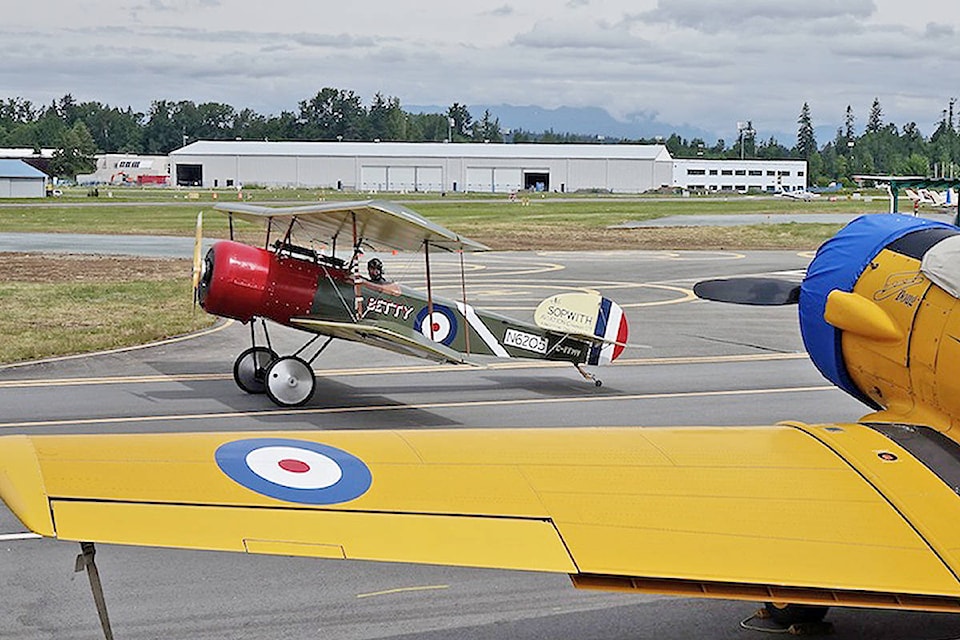The return of “Betty/Phyllis” was an emotional moment for people at the Canadian Museum of Flight at the Langley airport, Dave Arnold, museum senior manager said.
The replica Sopwith Pup, one of two First World War biplanes built by volunteers at the museum, touched down Saturday morning (June 17) at Langley airport.
“It was pretty emotional,” Arnold said.
“It was an 18-month project and it had completed its mission.”
Arnold said the celebration was limited to “coffee and cookies” because the other Pup still needs some work before it can take to the air, too.
“The time for champagne will be when we have both of them flying.”
The museum, which is struggling with space issues, now has to find room for the latest additions to its collection.
“Storage space is hard to find and it’s not cheap,” Arnold said.
Arnold said the museum did look into adding a canopy to one end of the museum building to increase space, but “that turns out to be expensive, too.”
Over the long run, the museum hopes to relocate to a new facility to the west of the north-south runway adjacent to Fraser Highway and the Derek Doubleday Arboretum.
The museum is fundraising for the new building and in March, the Museum’s DC-3 was moved to the new site, but Arnold said that doesn’t mean construction is imminent.
Remembering Vimy
“Betty/Phyllis” and “Happy” were built to commemorate the 100th anniversary of the Battle of Vimy Ridge.
They were flown to France and put on display last April as part of an international ceremony held to remember the 3,598 soldiers who died during the battle that is widely considered to be a defining moment in Canadian history.
In that First World War battle, April 9-12, 1917, four divisions of the Canadian Expeditionary Force captured the German fortification in France.
It came at a great cost, with 3,598 Canadian corps killed in action, and to this day the Vimy Ridge monument stands in the memorial park in recognition of Canada’s contributions and losses.
The aircraft recreated the look of the fighter flown by Canadian Ace Joseph Fall, who served in both the First and Second World Wars and had the name of his sisters, Betty and Phyllis painted on his plane.
As it was done in the First World War, the outside of the plane was painted with house paint, and the graphics were drawn freehand.
On one side, the name “Betty” is painted, and on the other is the name “Phyllis.”
Although many replicas of Fall’s plane have been made, the Canadian Museum of Flight’s is the only one to accurately portray both names, as period photographs show only “Betty” painted on the side.
The completed Pup was slightly smaller than the original pup, built from a kit made by Airdrome Aeroplanes in Holdren, Missouri.
The entire body has a layer of Dacron fabric tightly wrapped around instead of cotton or linen, which would have been used originally.
More than two dozen people, some of them air cadets, helped to build the Langley Sopwith Pups.
Because of an unexpected problem obtaining reliable engines, the planes were unable to take part in the flypast of World War One biplanes at the ceremony.
“It was very disappointing,” Arnold said, but noted the aircraft were still able to take part in the Vimy anniversary events overseas.
“We got it there and it was seen by thousands and thousands.”
The two Sopwith Pups were partially disassembled and packed into a Royal Canadian Air Force transport jet at Comox air force base for shipment to France, along with a Langley-built SE5a and four replica Nieuport 11 ‘Bebe’ biplanes of the same era built elsewhere.
The Museum’s SE5A took part in the flypast of near the Vimy Memorial on April 9 before a crowd of 25,000, including members of the Royal Family.
The single-seater Pup is technically known as the Scout, but the nickname stuck because pilots considered it to be the “pup” of the larger two-seater Sopwith.
Most Sopwith fighters that followed became part of what was known as the “flying zoo” with animal names like the Camel, Dolphin and Snipe.
The Vimy fly-past was inspired by a 1936 photo which depicted biplanes flying over the Vimy memorial during the opening ceremony of the memorial, which records the time and place where four divisions of the Canadian Corps fought together for the first time.
RCAF Capt. Brent Handy flew one of the Nieuport 11s over Vimy.
“I honestly felt like I won the lottery when I found out that I was assigned to the program,” Handy said.
The Nieuports, he said, were “top-line fighters” for their time.
It’s really thrilling. It’s a single cockpit airplane as well, so only one seat, so you have to teach yourself how to fly.”
In the First World War, pilots had little training before they left for war.
“They probably had about a grand total of four hours of flying experience, and they’re strapping these things on their back and heading out over the horizon to fight a war for us,” Handy said.
“To me, this experience is all about perspective — it’s just really opened my eyes as to what we’ve accomplished as a nation in 100 years, and what these veterans did for us.”
